ON-VEHICLE INSPECTION
PROCEDURE
1. INSPECT REFRIGERANT PRESSURE WITH MANIFOLD GAUGE SET
HINT:
The following examples show the readings of a manifold gauge set and the corresponding
air conditioning system problems.
(a) Read the manifold gauge pressure when the following conditions are met:
- Doors are fully open.
- The engine is idling.
- The A/C switch is on.
- The temperature is set to max cool.
- The blower speed is set to high.
- Temperature at the air inlet with recirculate selected is 30 to 35°C (86
to 95°F).
|
(1) Normally functioning air conditioning system
Gauge Reading
|
Pressure Side
|
Refrigerant Volume
|
|
Low
|
150 to 250 kPa (1.5 to 2.5 kgf/cm2, 22 to 36 psi)
|
|
High
|
1370 to 1570 kPa (14.0 to 16.0 kgf/cm2, 199 to 228 psi)
|
|
|
(2) Abnormally functioning air conditioning system
- During operation, pressure on low pressure side cycles between normal and
vacuum
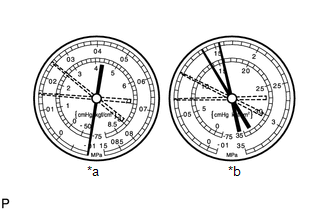
|
Symptom
|
Air conditioning system periodically cools and then fails to cool
|
|
Probable Cause
|
Moisture in air conditioning system freezes at expansion valve orifice,
causing refrigerant to temporarily stop circulating
|
|
After system stops and warms up again, ice melts and normal operation
is temporarily restored
|
|
Diagnosis
|
Cooler dryer (integrated into condenser tank) saturated with moisture
|
|
Moisture in air conditioning system is freezing at expansion valve
orifice and blocking circulation of refrigerant
|
|
Corrective Actions
|
Replace cooler dryer
|
|
Remove moisture by repeatedly evacuating air from air conditioning
system
|
|
Recharge air conditioning system with proper amount of new or purified
refrigerant
|
HINT:
For the example above, moisture is present in the air conditioning system.
- Pressure is low on both low and high pressure sides
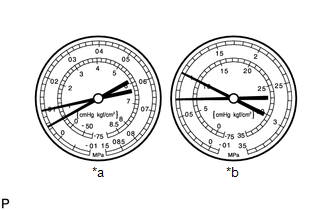
|
Symptom
|
Air conditioning system does not cool effectively
|
|
Insufficient cooling performance
|
|
Probable Cause
|
Refrigerant leaks from air conditioning system
|
|
Diagnosis
|
Insufficient refrigerant
|
|
Refrigerant leaking
|
|
Corrective Actions
|
Check for refrigerant leaks and repair if necessary
|
|
Recharge air conditioning system with proper amount of new or purified
refrigerant
|
|
If gauges indicate pressure of close to 0, then it is necessary to
evacuate air conditioning system after repairing leaks
|
HINT:
For the example above, there is insufficient refrigerant.
- Pressure is low on both low and high pressure sides
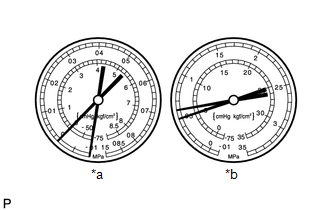
|
Symptom
|
Air conditioning system does not cool effectively
|
|
Frost exists on pipe from condenser to evaporator unit
|
|
Probable Cause
|
Refrigerant flow is obstructed by dirt inside pipes of condenser
core
|
|
Diagnosis
|
Condenser is clogged
|
|
Corrective Actions
|
Replace condenser
|
HINT:
For the example above, there is poor circulation of refrigerant.
- Vacuum is indicated on low pressure side and very low pressure is indicated
on high pressure side
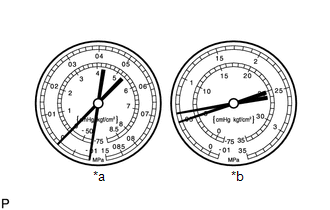
|
Symptom
|
Air conditioning system does not cool effectively (System may cool
occasionally)
|
|
Frost or condensation is seen on piping on both sides of receiver/dryer
or expansion valve
|
|
Probable Cause
|
Refrigerant flow is obstructed by moisture or dirt in air conditioning
system
|
|
Expansion valve is stuck closed
|
|
Diagnosis
|
Refrigerant does not circulate
|
|
Corrective Actions
|
Replace expansion valve
|
|
Replace condenser
|
|
Evacuate air conditioning system and recharge with proper amount
of new or purified refrigerant
|
HINT:
For the example above, the refrigerant does not circulate.
- Pressure is too high on both low and high pressure sides
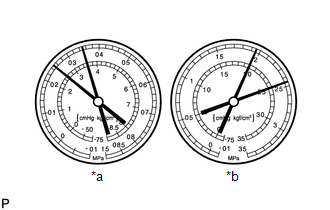
|
Symptom
|
Air conditioning system does not cool effectively
|
|
Probable Cause
|
Unable to provide sufficient performance due to excessive amount
of refrigerant
|
|
Cooling effectiveness of condenser is insufficient
|
|
Diagnosis
|
Excessive amount of refrigerant in air conditioning system because
excessive refrigerant was added during recharging
|
|
Cooling effectiveness of condenser is insufficient because condenser
fins are clogged or cooling fan is faulty
|
|
Corrective Actions
|
Clean condenser
|
|
Check operation of condenser cooling fan
|
|
If condenser is clean and fan operation is normal, check amount of
refrigerant and recharge air conditioning system with proper amount
of new or purified refrigerant
|
HINT:
For the example above, the air conditioning system is overcharged or cooling
effectiveness of condenser is insufficient.
- Pressure is too high on both low and high pressure sides
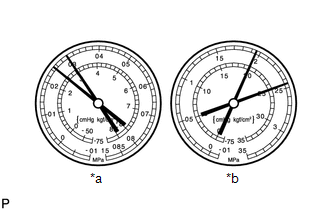
|
Symptom
|
Air conditioning system does not cool
|
|
The low pressure piping is too hot to touch
|
|
Probable Cause
|
Air in air conditioning system
|
|
Diagnosis
|
Air present in air conditioning system
|
|
Insufficient vacuum purging when evacuating air conditioning system
|
|
Corrective Actions
|
Replace cooler dryer
|
|
Check compressor oil to see if it is dirty or insufficient
|
|
Evacuate air conditioning system and recharge it with new or purified
refrigerant
|
NOTICE:
These gauge indications occur when the air conditioning system has been left
open and then recharged without evacuating the system.
HINT:
For the example above, air is present in the air conditioning system.
- Pressure is too high on both low and high pressure sides
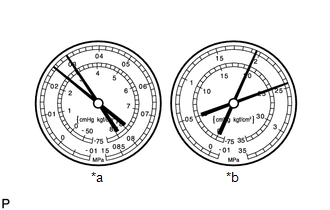
|
Symptom
|
Air conditioning system does not cool effectively
|
|
Frost or large amount of condensation on piping on low pressure side
|
|
Probable Cause
|
Expansion valve may be stuck open or metering refrigerant incorrectly
|
|
Diagnosis
|
Excessive refrigerant in low pressure piping
|
|
Expansion valve open too wide
|
|
Corrective Actions
|
Replace expansion valve
|
HINT:
For the example above, there is an expansion valve malfunction.
- Pressure is too high on both low and high pressure sides or pressure is
too low on high pressure side
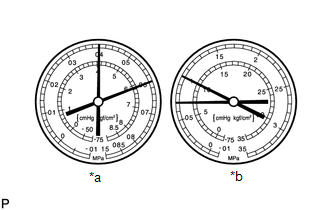
|
Symptom
|
Air conditioning system does not cool effectively
|
|
Probable Cause
|
Internal leak in compressor
|
|
Diagnosis
|
Low compression
|
|
Leak from damaged valve or other compressor component
|
|
Corrective Actions
|
Replace compressor
|
HINT:
For the example above, there is insufficient compressor compression.
(3) Gauge readings (Reference)
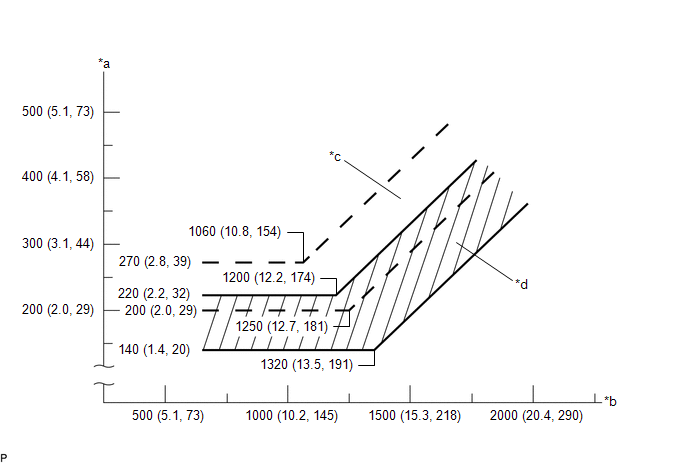
|
*a
|
Pressure on Low Pressure Side kPa (kgf/cm2, psi)
|
*b
|
Pressure on High Pressure Side kPa (kgf/cm2, psi)
|
|
*c
|
Blower High Zone
|
*d
|
Blower Low Zone
|
|
